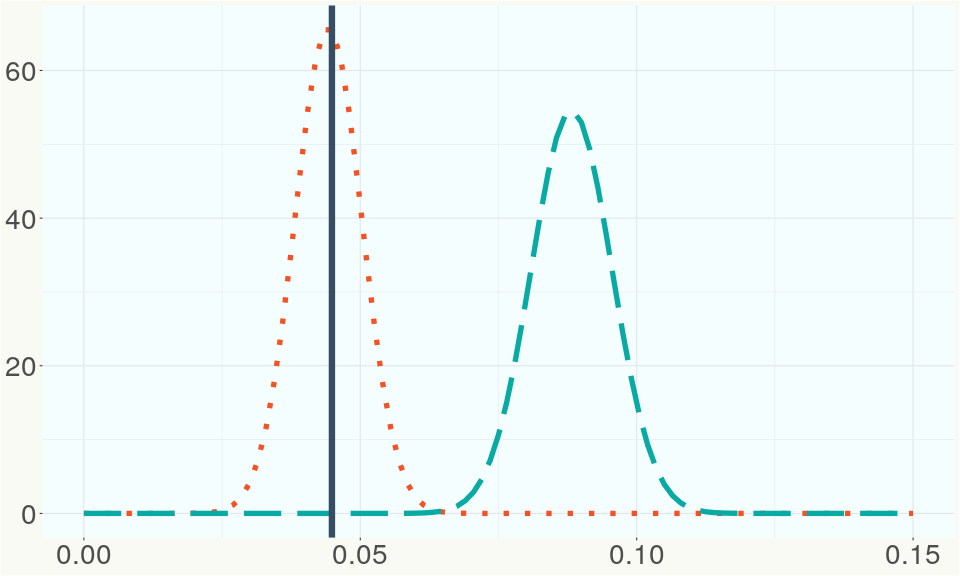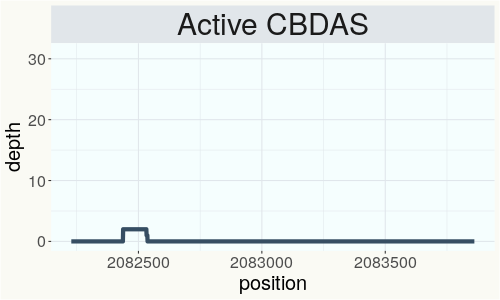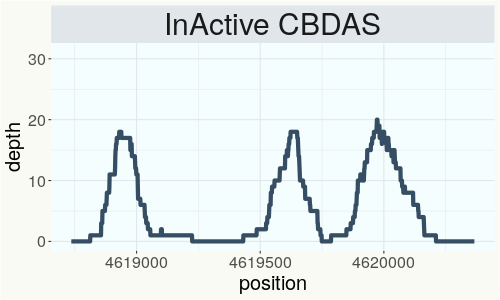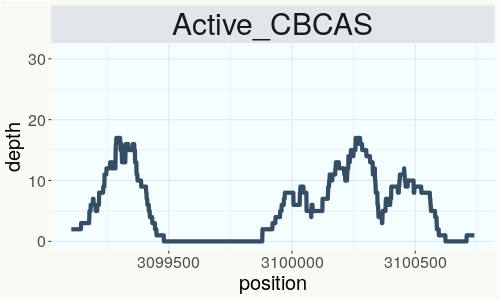Durban Poison
RSP 10998
Grower: DigiPath Labs
General Information
- Sample Name
- F20161209-03-8
- Accession Date
- August 28, 2017
- Reported Plant Sex
- Female
- Report Type
- StrainSEEK v2 3.2Mb
- DNA Extracted From
- Unknown
The strain rarity visualization shows how distant the strain is from the other cultivars in the Kannapedia database. The y-axis represents genetic distance, getting farther as you go up. The width of the visualization at any position along the y-axis shows how many strains there are in the database at that genetic distance. So, a common strain will have a more bottom-heavy shape, while uncommon and rare cultivars will have a visualization that is generally shifted towards the top.
Chemical Information
Cannabinoid and terpenoid information provided by the grower.
Cannabinoids
- THC + THCA
- 23.3%
- CBD + CBDA
- 0.035%
- THCV + THCVA
- 0.038%
- CBC + CBCA
- 0.019%
- CBG + CBGA
- 0.85%
- CBN + CBNA
- 0.146%
Terpenoids
- α-Bisabolol
- 0.001%
- Borneol
- n/a
- Camphene
- 0.002%
- Carene
- 0.102%
- Caryophyllene oxide
- 0.001%
- β-Caryophyllene
- 0.065%
- Fenchol
- n/a
- Geraniol
- 0.006%
- α-Humulene
- 0.063%
- Limonene
- 0.084%
- Linalool
- 0.005%
- Myrcene
- 0.174%
- α-Phellandrene
- n/a
- Terpinolene
- 0.585%
- α-Terpineol
- n/a
- α-Terpinene
- 0.049%
- γ-Terpinene
- 0.843%
- Total Nerolidol
- 0.005%
- Total Ocimene
- 0.283%
- α-Pinene
- 0.118%
- β-Pinene
- 0.194%
Genetic Information
- Plant Type
- Type I
File Downloads
The bell curve in the heterozygosity visualization shows the distribution of heterozygosity levels for cannabis cultivars in the Kannapedia database. The green line shows where this particular strain fits within the distribution. Heterozygosity is associated with heterosis (aka hybrid vigor) but also leads to the production of more variable offspring. When plants have two genetically different parents, heterozygosity levels will be higher than if it has been inbred or backcrossed repeatedly.
The ratio of reads mapped to Y-contigs to reads mapped to the whole Cannabis genome (Y-ratios) has been demonstrated to be strongly correlated with plant sex typing. This plot shows the distribution of Y-ratios for all samples in our database which were sequenced with the same method (panel or WGS) as this sample and where this sample falls in the distribution.

This chart represents the Illumina sequence coverage over the Bt/Bd allele. These are the three regions in the cannabis genome that impact THCA, CBDA, CBGA production. Coverage over the Active CBDAS gene is highly correlated with Type II and Type III plants as described by Etienne de Meijer. Coverage over the THCA gene is highly correlated with Type I and Type II plants but is anti-correlated with Type III plants. Type I plants require coverage over the inactive CBDA loci and no coverage over the Active CBDA gene. Lack of coverage over the Active CBDA and Active THCA allele are presumed to be Type IV plants (CBGA dominant). While deletions of entire THCAS and CBDAS genes are the most common Bt:Bd alleles observed, it is possible to have plants with these genes where functional expression of the enzyme is disrupted by deactivating point mutations (Kojoma et al. 2006).



This chart represents the Illumina sequence coverage over the CBCA synthase gene.

Variants (THCAS, CBDAS, and CBCAS)
No variants to report
Variants (Select Genes of Interest)
| PKSG-2a | c.67T>A | p.Phe23Ile | missense variant | moderate | contig700 | 1945567 | A/T | |
| PKSG-2a | c.31A>T | p.Thr11Ser | missense variant | moderate | contig700 | 1945603 | T/A | |
| PKSG-4b | c.496A>G | p.Lys166Glu | missense variant | moderate | contig700 | 2721177 | T/C | |
| PKSG-4b | c.489delT | p.Phe163fs | frameshift variant | high | contig700 | 2721183 | CA/C | |
| PKSG-4b | c.485A>G | p.Lys162Arg | missense variant | moderate | contig700 | 2721188 | T/C | |
| aPT4 | c.1168T>C | p.Tyr390His | missense variant | moderate | contig121 | 2833503 | T/C |
|
| aPT1 | c.406A>G | p.Ile136Val | missense variant | moderate | contig121 | 2839605 | A/G | |
| aPT1 | c.629C>T | p.Thr210Ile | missense variant | moderate | contig121 | 2840237 | C/T | |
| HDS-2 |
c.82_93delGT |
p.Val28_Thr3 |
conservative inframe deletion | moderate | contig95 | 1989748 |
CGTAACCGGAAC |
|
Nearest genetic relatives (All Samples)
- 0.002 Durban Poison (RSP11226)
- 0.006 Durban Poison #1 (RSP11013)
- 0.007 Durban Poison #1 (RSP10996)
- 0.007 Durban Poison (RSP11014)
- 0.135 Black Jack (RSP10603)
- 0.147 RKM-2018-025 (RSP11117)
- 0.147 BLACK JACK (RSP11346)
- 0.148 RKM-2018-016 (RSP11108)
- 0.149 Domnesia (RSP11184)
- 0.172 Lift (RSP11378)
- 0.172 Gold Cracker (RSP11048)
- 0.175 Electra (RSP11366)
- 0.176 Saint Jack (RSP11179)
- 0.182 RKM-2018-027 (RSP11119)
- 0.184 Serious Happiness (RSP10763)
- 0.188 Gold Cracker (RSP11041)
- 0.190 Cheese (RSP10460)
- 0.192 UnObtanium (RSP11611)
- 0.196 Doug s Varin (RSP11243)
- 0.199 Tangerine Haze (RSP10995)
Most genetically distant strains (All Samples)
- 0.429 Cherry Blossom (RSP11323)
- 0.411 80E (RSP11213)
- 0.400 Cherry Blossom (RSP11314)
- 0.392 80E (RSP11212)
- 0.391 Cherry Blossom (RSP11318)
- 0.387 Cherry Blossom (RSP11317)
- 0.383 Cherry Blossom (RSP11311)
- 0.381 80E (RSP11211)
- 0.380 Cherry Blossom (RSP11274)
- 0.378 CS (RSP11208)
- 0.378 Feral (RSP11205)
- 0.375 IUP2 (SRR14708257)
- 0.375 Cherry Blossom (RSP11306)
- 0.374 Cherry Blossom (RSP11333)
- 0.374 Kush Hemp E1 (RSP11128)
- 0.374 Feral (RSP10891)
- 0.370 IUP3 (SRR14708256)
- 0.369 R1in136 (SRR14708227)
- 0.368 Tanao Sri -46- (RSP11486)
- 0.367 Carmaleonte (RSP11207)
Nearest genetic relative in Phylos dataset
- Overlapping SNPs:
- 99
- Concordance:
- 95
Nearest genetic relative in Lynch dataset
- Overlapping SNPs:
- 11
- Concordance:
- 10
Blockchain Registration Information
- Transaction ID
-
0227f127b2679f9f
055219de913e02a4 5807410093689377 997334bb2cdc3151 - Stamping Certificate
- Download PDF (842.4 KB)
- SHASUM Hash
-
bdfa4c953a59ff0b1fc56c4df04ede88 67e694ec210617f0 6e87b72409e68c6a